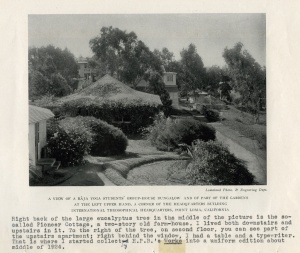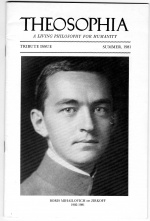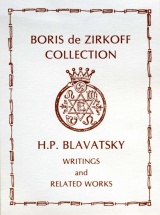Boris de Zirkoff: Difference between revisions
No edit summary |
No edit summary |
||
| Line 16: | Line 16: | ||
Modern genealogists would call this relationship "second cousin once removed." | Modern genealogists would call this relationship "second cousin once removed." | ||
Young Boris was tutored at home. He had an aptitude for languages, eventually mastering Russian, English, Swedish, German, and French, as well as the classics. As a boy in Russia, Boris was aware of his famous relative, but knew little of her. | |||
Turmoil of the Russian Revolution in 1917 forced Boris to flee with his mother and stepfather across Finland. After settling in Sweden, he discovered ''The Secret Doctrine''. According to one account, he found a Swedish translation in a library,<ref>John Cooper. "Last Link with H. P. Blavatsky Broken: Death of Boris de Zirkoff (1902-1981)." ''Theosophy in Australia'' 45.2 (June 1981): 232-233.</ref> but another version of the story tells that he first saw HPB's masterwork in the home of the Russian Consul.<ref>"Zirkoff, Boris de". ''Theosophical Encyclopedia''. Quezon City, Philippines: Theosophical Publishing Company, 2006. 688-689. Available at [http://theosophy.ph/encyclo/index.php?title=Zirkoff,_Boris_de Theosopedia],</ref> The [[Theosophical Movement]] was well established in Sweden at that time. De Zirkoff met [[Katherine Tingley]] during one of her European tours as head of the [[Universal Brotherhood and Theosophical Society]], and she invited him to live at Point Loma. | |||
[[File:BdeZ life at Point Loma.jpg|300px|right|thumb|Notes typed by B de Z on a photograph show where he worked at Point Loma. Image from TSA Archives.]] | [[File:BdeZ life at Point Loma.jpg|300px|right|thumb|Notes typed by B de Z on a photograph show where he worked at Point Loma. Image from TSA Archives.]] | ||
== Life at Point Loma == | == Life at Point Loma == | ||
Late in 1923, the 21-year-old de Zirkoff left Sweden, where he was living in the home of Mrs. Wicander, to move to the [[Point Loma]] community | Late in 1923, the 21-year-old de Zirkoff left Sweden, where he was living in the home of Mrs. Wicander, to move to the [[Point Loma]] community. There he became acquainted with pupils of HPB including [[Henry T. Edge|Dr. Henry T. Edge]], [[Charles J. Ryan]], [[Reginald Machell]], and [[Herbert Coryn|Dr. Herbert Coryn]]. | ||
<br> | <br> | ||
<br> | <br> | ||
| Line 36: | Line 35: | ||
<br> | <br> | ||
== Editorship of ''Theosophia'' == | == Editorship of ''Theosophia'' == | ||
[[File:Boris De Zirkoff on Theosophia cover.JPG|150px|left|Boris de Zirkoff on | [[File:Boris De Zirkoff on Theosophia cover.JPG|150px|left|thumb|Boris de Zirkoff on final issue of ''Theosophia'']]. | ||
[[Theosophia (periodical)|'''''Theosophia''''']] was an independent quarterly periodical published in Los Angeles from May-June 1944 to Summer 1981. The final issue, pictured here, was a tribute to the recently deceased editor. | [[Theosophia (periodical)|'''''Theosophia''''']] was an independent quarterly periodical published in Los Angeles from May-June 1944 to Summer 1981. The final issue, pictured here, was a tribute to the recently deceased editor. | ||
<br> | <br> | ||
<br> | <br> | ||
Throughout its existence, the magazine maintained a neutral attitude toward the various Theosophical organizations, and a high standard of scholarship. Every issue began with an article by Boris de Zirkoff. Schedules of lectures were often listed for the Los Angeles and San Diego areas. Book reviews and transcriptions of radio lectures and interviews were occasionally included. | |||
<br> | <br> | ||
<br> | <br> | ||
Excerpts from Blavatsky's writings were frequently featured. The best writers from all the Theosophical traditions had articles printed on its pages. Some well-known authors were [[William Quan Judge]], [[Henry Steel Olcott]], [[Gottfried de Purucker]], [[Mary K. Neff]], [[Sven Eek]], [[Ernest Wood]], [[Henry T. Edge]], [[Charles Johnston]], [[Josephine Ransom]], [[Manly P. Hall]], [[L. Gordon Plummer]], [[Herbert Coryn]], [[George William Russell]] writing as AE, and [[Julia Keightley]] writing as Jasper Niemand. Harold W. Dempster and Arthur L. Joquel were among the most frequent contributors. | |||
== Collected Writings project == | == Collected Writings project == | ||
<br> | <br> | ||
Revision as of 03:51, 3 September 2013

Boris de Zirkoff (1902–1981) was a relative of H. P. Blavatsky and the editor of her written works. He lived for many years in the Point Loma community, where he created and edited the periodical Theosophia.
Early years
De Zirkoff was born in Petrograd, Russia [now known as Saint Petersburg] on March 7, 1902. His mother was Lydia Dmitriyevna von Hahn.[1] who was a second cousin to Helena Petrovna Blavatsky. His father was Mihail Vassilyevich de Zirkoff, a general in the Russian Imperial Army.[2] He described his family relationship to Helena Petrovna Blavatsky in this way:
Her father and my grandfather (my mother's father) were cousins. There was a considerable diference in age between the two branches of the family; hence I was born after HPB had died. This makes me something like a grand-nephew of HPB.[3]
Modern genealogists would call this relationship "second cousin once removed."
Young Boris was tutored at home. He had an aptitude for languages, eventually mastering Russian, English, Swedish, German, and French, as well as the classics. As a boy in Russia, Boris was aware of his famous relative, but knew little of her.
Turmoil of the Russian Revolution in 1917 forced Boris to flee with his mother and stepfather across Finland. After settling in Sweden, he discovered The Secret Doctrine. According to one account, he found a Swedish translation in a library,[4] but another version of the story tells that he first saw HPB's masterwork in the home of the Russian Consul.[5] The Theosophical Movement was well established in Sweden at that time. De Zirkoff met Katherine Tingley during one of her European tours as head of the Universal Brotherhood and Theosophical Society, and she invited him to live at Point Loma.
Life at Point Loma
Late in 1923, the 21-year-old de Zirkoff left Sweden, where he was living in the home of Mrs. Wicander, to move to the Point Loma community. There he became acquainted with pupils of HPB including Dr. Henry T. Edge, Charles J. Ryan, Reginald Machell, and Dr. Herbert Coryn.
Editorship of Theosophia
.
Theosophia was an independent quarterly periodical published in Los Angeles from May-June 1944 to Summer 1981. The final issue, pictured here, was a tribute to the recently deceased editor.
Throughout its existence, the magazine maintained a neutral attitude toward the various Theosophical organizations, and a high standard of scholarship. Every issue began with an article by Boris de Zirkoff. Schedules of lectures were often listed for the Los Angeles and San Diego areas. Book reviews and transcriptions of radio lectures and interviews were occasionally included.
Excerpts from Blavatsky's writings were frequently featured. The best writers from all the Theosophical traditions had articles printed on its pages. Some well-known authors were William Quan Judge, Henry Steel Olcott, Gottfried de Purucker, Mary K. Neff, Sven Eek, Ernest Wood, Henry T. Edge, Charles Johnston, Josephine Ransom, Manly P. Hall, L. Gordon Plummer, Herbert Coryn, George William Russell writing as AE, and Julia Keightley writing as Jasper Niemand. Harold W. Dempster and Arthur L. Joquel were among the most frequent contributors.
Collected Writings project
De Zirkoff's work received international recognition and cooperation from the major Theosophical organizations. In 1981 he was awarded the Subba Row Medal of the Theosophical Society (Adyar) to acknowledge his superb contributions to Theosophical literature.
Other writings
Archival legacy
Boris de Zirkoff left his fine library to the Henry S. Olcott Memorial Library of the Theosophical Society in America, where it is held intact in the Rare Books Room. His papers, including his correspondence and research files used in his work on H. P Blavatsky's collected writings and her letters, are in the Archives Department.
Notes
- ↑ "Zirkoff, Boris de". Theosophical Encyclopedia. Quezon City, Philippines: Theosophical Publishing Company, 2006. 688-689. Available at Theosopedia,
- ↑ John Cooper. "Last Link with H. P. Blavatsky Broken: Death of Boris de Zirkoff (1902-1981)." Theosophy in Australia 45.2 (June 1981): 232-233.
- ↑ Letter to Gertrud Bäzner. July 30, 1969. Boris de Zirkoff Papers. Record Series 22. Theosophical Society in American Archives, Wheaton, Illinois.
- ↑ John Cooper. "Last Link with H. P. Blavatsky Broken: Death of Boris de Zirkoff (1902-1981)." Theosophy in Australia 45.2 (June 1981): 232-233.
- ↑ "Zirkoff, Boris de". Theosophical Encyclopedia. Quezon City, Philippines: Theosophical Publishing Company, 2006. 688-689. Available at Theosopedia,


